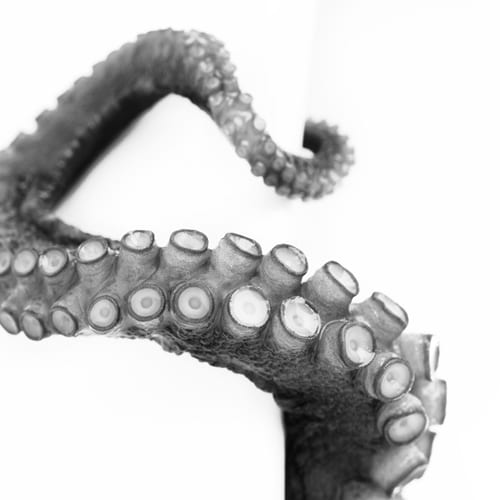New adhesive system could be powerful tool for underwater salvage, rescue operations.
Over the last few years, Virginia Tech scientists have been looking to the octopus for inspiration to design technologies that can better grip a wide variety of objects in underwater environments. Their latest breakthrough is a special switchable adhesive modeled after the shape of the animal’s suckers, according to a new paper published in the journal Advanced Science.
“I am fascinated with how an octopus in one moment can hold something strongly, then release it instantly. It does this underwater, on objects that are rough, curved, and irregular—that is quite a feat,” said co-author and research group leader Michael Bartlett. “We’re now closer than ever to replicating the incredible ability of an octopus to grip and manipulate objects with precision, opening up new possibilities for exploration and manipulation of wet or underwater environments.”
As previously reported, there are several examples in nature of efficient ways to latch onto objects in underwater environments, per the authors. Mussels, for instance, secrete adhesive proteins to attach themselves to wet surfaces, while frogs have uniquely structured toe pads that create capillary and hydrodynamic forces for adhesion. But cephalopods like the octopus have an added advantage: The adhesion supplied by their grippers can be quickly and easily reversed, so the creatures can adapt to changing conditions, attaching to wet and dry surfaces.
From a mechanical engineering standpoint, the octopus has an active, pressure-driven system for adhesion. The sucker’s wide outer rim creates a seal with the object via a pressure differential between the chamber and the surrounding medium. Then muscles (serving as actuators) contract and relax the cupped area behind the rim to add or release pressure as needed.
There have been several attempts to mimic cephalopods when designing soft robotic grippers, for example. Back in 2022, Bartlett and his colleagues wanted to go one step further and recreate not just the switchable adhesion but also the integrated sensing and control. The result was Octa-Glove, a wearable system for gripping underwater objects that mimicked the arm of an octopus.
For the adhesion, they designed silicone stalks capped with a pneumatically controlled membrane, mimicking the structure of octopus suckers. These adhesive elements were then integrated with an array of LIDAR optical proximity sensors and a micro-control for the real-time detection of objects. When the sensors detect an object, the adhesion turns on, mimicking the octopus’s nervous and muscular systems. The team used a neoprene wetsuit glove as a base for the wearable glove, incorporating the adhesive elements and sensors in each finger, with flexible pneumatic tubes inserted at the base of the adhesive elements.
This latest research builds on those prior innovations in hopes of further improving the Octa-Glove. Octopus suckers are biological tissue and thus can warp, expand, and contract as needed to grip a wide variety of objects. So Bartlett et al. designed a similar elastic curved silicone stalk outfitted with an active, deformable membrane capable of changing shape to better adhere to different types of surfaces.
As before, switching between grip and release is controlled via pneumatic pressure. The switching occurs in about 30 milliseconds, resulting in adhesives that are 1,000 times stronger when activated for gripping than in release mode. The team tested the adhesives both individually and in arrays of five and found that the latter deployment linearly increased the attachment force, while attachment strength remained constant—ideal for supporting larger loads. The adhesives worked on a broad range of sizes, shapes, and surface textures, from rocks to fragile hydrogel balls.
As a further proof of concept, the team used their octo-adhesive system to build an underwater cairn (rock pile) out of stones varying in size, shape, and surface roughness. The manipulation is similar to how octopuses arrange objects in their dens. Additional experiments showed that the adhesives could attach to objects over and over for as many as 100 cycles, even holding one rock underwater for over seven days before releasing it on demand. That’s a very useful capability for underwater salvage or rescue operations.
“This work points to the importance of contact geometry for successful underwater attachment and release,” the authors concluded. “This can guide future work on synthetic underwater adhesives, where additional contact geometries such as stalk architecture and membrane shape, or tuning actuation schemes, may further control attachment.”
Read more at arstechnica.com





